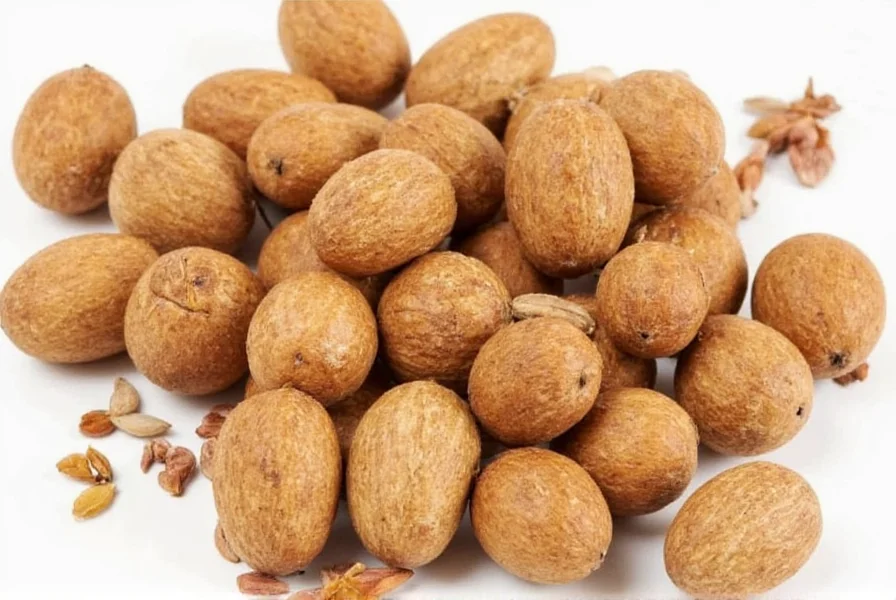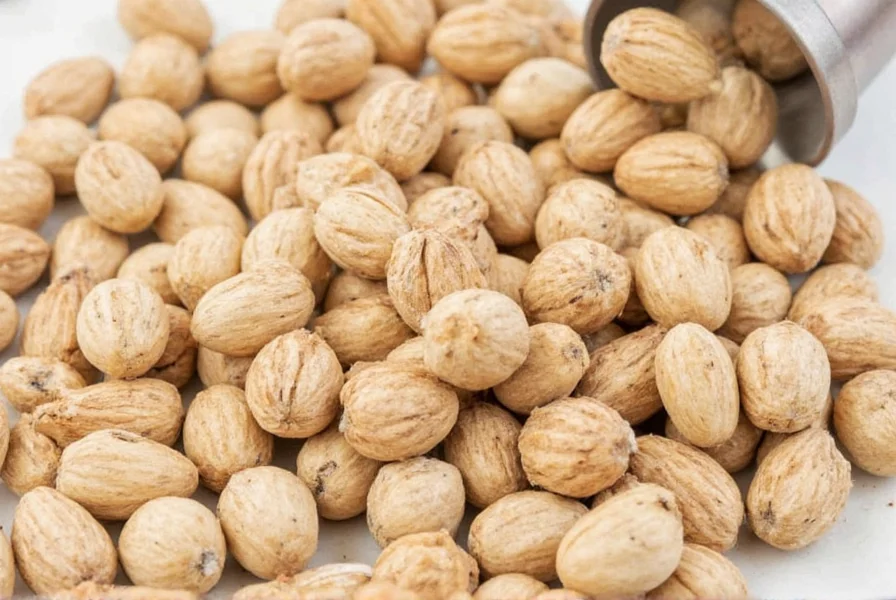Running out of nutmeg mid-recipe doesn't have to ruin your culinary creation. Whether you're baking holiday cookies, preparing creamy béchamel sauce, or crafting a signature curry, knowing effective nutmeg alternatives keeps your cooking on track. This guide provides practical, tested substitutions that maintain the warm, slightly sweet, and nutty essence nutmeg brings to dishes.
Why You Might Need a Nutmeg Substitute
Nutmeg's distinctive flavor enhances both sweet and savory dishes, but pantry shortages happen. Some cooks seek alternatives due to nutmeg's potential blood-thinning properties during pregnancy, while others need options for those with rare nutmeg allergies. Understanding proper substitutes prevents recipe failures and expands your spice knowledge for more versatile cooking.
Top 7 Nutmeg Substitutes Ranked by Effectiveness
1. Mace: The Closest Flavor Match
Mace comes from the same plant as nutmeg (Myristica fragrans) but uses the outer covering of the seed. This makes it nutmeg's closest relative in flavor profile. Use mace in a 1:1 ratio for most applications. It works exceptionally well in creamy sauces, mashed potatoes, and custards where nutmeg's warmth enhances without overpowering.

2. Allspice: The Versatile Alternative
Allspice combines notes of cinnamon, cloves, and nutmeg, making it an excellent substitute. Use ½ teaspoon allspice for every 1 teaspoon of nutmeg required. This substitution shines in baked goods like pumpkin bread and spiced cakes. Be cautious with savory dishes as allspice's clove notes can dominate if overused.
3. Ginger: For Bright, Zesty Replacement
Fresh or ground ginger provides a warm, slightly peppery alternative. Substitute ½ teaspoon ground ginger for 1 teaspoon nutmeg. This works particularly well in Asian-inspired dishes, chai tea blends, and certain baked goods. Ginger adds a brighter note than nutmeg's earthiness, so adjust other spices accordingly.
4. Cinnamon: The Sweet Option
When nutmeg's warmth is needed in sweet applications, cinnamon serves as a reliable stand-in. Use ¼ teaspoon cinnamon per 1 teaspoon nutmeg. This substitution works best in desserts, fruit compotes, and oatmeal. Avoid using cinnamon as a substitute in savory dishes where nutmeg's more complex profile is essential.
5. Pumpkin Pie Spice: The Convenient Blend
This pre-mixed spice blend typically contains nutmeg along with cinnamon, ginger, and cloves. Use pumpkin pie spice in a 1:1 ratio when nutmeg appears in sweet recipes. It's particularly effective in fall baking, smoothies, and coffee drinks. Check your blend's ingredients as proportions vary between brands.
6. Cardamom: For Floral Complexity
Cardamom offers a floral, citrusy warmth that can mimic nutmeg's complexity in certain applications. Substitute ¼ teaspoon cardamom for 1 teaspoon nutmeg. This works surprisingly well in Scandinavian baking, rice pudding, and some curry recipes. Cardamom's distinct flavor means it won't work as a universal substitute but shines in specific cultural dishes.
7. Cloves: The Potent Last Resort
Use cloves sparingly as a nutmeg alternative—only ⅛ teaspoon ground cloves replaces 1 teaspoon nutmeg. Cloves bring intense warmth but can easily overwhelm a dish. Reserve this substitution for mulled wines, certain stews, and holiday baking where their strong flavor complements other ingredients.
| Substitute | Ratio (vs Nutmeg) | Best For | Flavor Notes | Limitations |
|---|---|---|---|---|
| Mace | 1:1 | Cream sauces, custards, mashed potatoes | Nearly identical, slightly more delicate | Less common in standard pantries |
| Allspice | 1:2 | Baked goods, spice cakes, some curries | Clove-cinnamon notes, warmer | Can overpower savory dishes |
| Ginger | 1:2 | Chai, Asian dishes, certain desserts | Brighter, more peppery | Lacks nutmeg's earthiness |
| Cinnamon | 1:4 | Sweet applications only | Sweeter, less complex | Not suitable for savory dishes |
| Pumpkin Pie Spice | 1:1 | Fall baking, smoothies, desserts | Blended warmth with multiple spices | Variable composition between brands |
Special Considerations for Nutmeg Substitutes
When substituting nutmeg in béchamel or cheese sauces, mace provides the most seamless transition. For holiday baking, pumpkin pie spice often delivers better results than single-spice alternatives. In savory applications like meatloaf or roasted vegetables, allspice works better than cinnamon which would make dishes taste dessert-like.
Consider the dish's other ingredients when choosing a substitute. A recipe already containing cinnamon might benefit more from ginger or cardamom instead. For delicate dishes like custards or white sauces, use slightly less substitute than recommended to avoid flavor dominance.
When Not to Substitute Nutmeg
Some recipes rely specifically on nutmeg's unique chemical compounds that don't exist in substitutes. Traditional eggnog, certain Indian kormas, and classic béchamel for lasagna verde benefit most from authentic nutmeg. If possible, purchase whole nutmeg—it lasts longer and grates fresh for superior flavor compared to pre-ground versions.
Storing Your Nutmeg Substitutes Properly
Maximize shelf life by storing substitutes in airtight containers away from heat and light. Ground spices maintain potency for 6-12 months, while whole spices like mace blades or cinnamon sticks last 2-3 years. For best results with substitutes, purchase small quantities and replace regularly to ensure vibrant flavor when you need them most.
Practical Application: Substitute in Action
When making a creamy spinach soup that calls for ¼ teaspoon nutmeg, try ⅛ teaspoon allspice plus a pinch of ginger. The allspice provides warmth while the ginger adds brightness that complements the spinach. For apple pie requiring ½ teaspoon nutmeg, use ¼ teaspoon cinnamon plus ⅛ teaspoon cardamom for a more complex spice profile that enhances rather than masks the fruit.
Frequently Asked Questions
Can I use cinnamon instead of nutmeg in béchamel sauce?
Cinnamon doesn't work well as a nutmeg substitute in béchamel sauce as it creates an overly sweet flavor that clashes with the savory profile. Mace is the best substitute for béchamel, using a 1:1 ratio, as it provides similar warmth without sweetness.
What's the best nutmeg substitute for pumpkin pie?
Pumpkin pie spice makes the best nutmeg substitute for pumpkin pie since it already contains nutmeg along with complementary spices. Use it in a 1:1 ratio. If unavailable, a blend of ¼ tsp cinnamon plus ⅛ tsp ginger per ½ tsp nutmeg creates a suitable alternative.
How much allspice equals 1 teaspoon of nutmeg?
Use ½ teaspoon of allspice to replace 1 teaspoon of nutmeg. Allspice contains nutmeg-like compounds but also has stronger clove notes, so using the full amount would overpower most dishes. This ratio works best in baked goods and some savory applications.
Is mace stronger than nutmeg?
Mace has a more delicate flavor than nutmeg despite coming from the same plant. It's slightly less intense, which is why you can use it in a 1:1 ratio as a substitute. Mace works particularly well in lighter dishes like béchamel sauce or custards where whole nutmeg might be too strong.
Can I omit nutmeg from a recipe entirely?
You can omit nutmeg, but you'll lose its distinctive warm, slightly sweet flavor that enhances both sweet and savory dishes. In most recipes, the dish will still work without it, but for best results, use one of the recommended substitutes to maintain the intended flavor profile.











 浙公网安备
33010002000092号
浙公网安备
33010002000092号 浙B2-20120091-4
浙B2-20120091-4